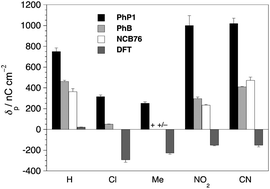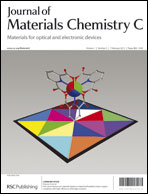Ferroelectric liquid crystals induced by dopants with axially chiral 2,2′-spirobiindan-1,1′-dione cores: substituent effect on the polarization power†
Abstract
Dopants with axially chiral 2,2′-spirobiindan-1,1′-dione cores induce a spontaneous polarization PS in the SmC liquid crystal phase that varies with the structure of the liquid crystal host. This host dependence of the polarization power δp was rationalized based on an equilibrium between two conformations of opposite polarities (P and C2) that conform to the binding site of the Boulder model. In order to test this conformational distribution model, we modified the structure of the dopant (R)-5,5′-diheptyloxy-2,2′-spirobiindan-1,1′-dione ((R)-2-H) by introducing a substituent at the 6-position of one indanone segment to give the series (R)-2-X in enantiomerically pure form, where X = Cl, Me, CN and NO2. The effect of each substituent on δp was measured in four different liquid crystal hosts PhP1, PhB, NCB76 and DFT. The results reported herein show that the substituent X has a significant effect on δp in each of the four hosts, but suggest that the P/C2 model in a passive dopant mode cannot account for the observed trends in δp and that the effect of chirality transfer on rotational and/or conformational distribution must be taken into account. Nevertheless, the results show that δp can be tuned over a wide dynamic range—from +1019 nC cm−2 to −293 nC cm−2—by varying the substituent X.


 Please wait while we load your content...
Please wait while we load your content...